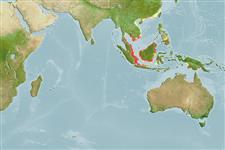Environment: milieu / climate zone / depth range / distribution range
Écologie
marin démersal; non migrateur; profondeur ? - 32 m (Ref. 9790). Tropical
Western Pacific: Hainan Island, China, the South China Sea, the Gulf of Thailand and Johore shoals of Malaysia.
Taille / Poids / Âge
Maturity: Lm ? range ? - ? cm
Max length : 30.0 cm TL mâle / non sexé; (Ref. 9790); common length : 25.0 cm tl mâle / non sexé; (Ref. 9790)
Épines dorsales (Total) : 9; Rayons mous dorsaux (Total) : 12; Épines anales: 0; Rayons mous anaux: 12. Lateral line scales frequently 53, each scale with a backward directed spine that does not extend beyond rear margin of scale. Interorbital width less than 9% of head length. Caudal fin frequently with 2 dark bands posteriorly. Dorsal fin rays IX, I,VIII, or I,VII,I, usually I,VIII.
Life cycle and mating behavior
Maturities | Reproduction | Spawnings | Egg(s) | Fecundities | Larves
Knapp, L.W., 1999. Platycephalidae. Flatheads. p. 2385-2421. In K.E. Carpenter and V.H. Niem (eds.) FAO species identification guide for fishery purposes. The living marine resources of the Western Central Pacific. Volume 4. Bony fishes part 2 (Mugilidae to Carangidae). FAO, Rome. (Ref. 9790)
Statut dans la liste rouge de l'IUCN (Ref. 130435)
Menace pour l'homme
Harmless
Utilisations par l'homme
Outils
Articles particuliers
Télécharger en XML
Sources Internet
Estimates based on models
Preferred temperature (Ref.
123201): 26 - 29.2, mean 28.8 °C (based on 1064 cells).
Phylogenetic diversity index (Ref.
82804): PD
50 = 0.6250 [Uniqueness, from 0.5 = low to 2.0 = high].
Bayesian length-weight: a=0.01000 (0.00244 - 0.04107), b=3.04 (2.81 - 3.27), in cm total length, based on all LWR estimates for this body shape (Ref.
93245).
Niveau trophique (Ref.
69278): 3.8 ±0.6 se; based on size and trophs of closest relatives
Résilience (Ref.
120179): Milieu, temps minimum de doublement de population : 1,4 à 4,4 années (Preliminary K or Fecundity.).
Fishing Vulnerability (Ref.
59153): Low vulnerability (20 of 100).
